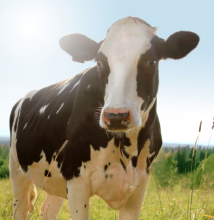Omega Ratio: Part 2

This post is an installment in our 52 Health Hinges series. Remember, “Small hinges swing big doors.”
[Click here for Part 1 of the 2-part Omega Ratio series.]
Last summer, my mother-in-law returned from a road trip through Texas and mentioned how sickened she was to see the ridiculously huge factory cattle farms along the roadside. There’s a lot to be sickened by when it comes to factory farming; they’re bad for the animals, bad for the environment, and bad for you.
Today, I want to zero in on one of the ways that factory farms are directly impacting your health.
In short, you are what you eat eats.
The late Dr. David Servan-Schreiber describes it nicely in his book, Anticancer:
“In the natural cycle, cows give birth in spring, when the grass is most luxuriant, and produce milk for several months until summer’s end. Spring grass is an especially rich source of omega-3 fatty acids; these fatty acids are therefore concentrated in the milk from cows raised in pastures and in the milk’s derivatives— butter, cream, yogurt, and cheese. Omega-3s are likewise found in beef from grass-fed cattle and in eggs from free-range chickens fed with forage (rather than grain).
“Starting in the fifties, the demand for milk products and beef went up so much that farmers had to look for shortcuts in the natural cycle of milk production and reduce the grazing area needed to feed a 750-kilogram (1,600-pound) cow. Pastures were thus abandoned and replaced by battery farming. Corn, soy, and wheat, which have become the principal diet for cattle, contain practically no omega-3 fatty acids. To the contrary, these food sources are rich in omega-6s.”
So, to put it simply; grains are high in Omega-6 fatty acid. Greens are high in Omega-3 fatty acid.
When you take animals out of their natural habitat and feed them food they’re not meant to eat, there are negative consequences.
Even though factory-farmed meat and pastured meat might appear the same, the chemical makeup of these of the two is so different that they are truly and completely different foods.
In turn, when you consume these different foods, they’ll be processed differently in your body. When you consume products from these grain-fed animals, you, too, will be consuming more grains than greens.
Thus, more Omega-6 fatty acids than Omega-3s. And you end up with an imbalanced ratio and silent inflammation.
Let me repeat: you are what you eat eats.
Wow.
Let’s dig into this a bit more by looking at some specific fatty-acid content of various sources (Omega-6 is stated first, followed by Omega-3; remember your goal is 1:1):
- Grass-fed beef – 3:1
- Feedlot beef - 20:1
- Chicken breast – 19:1
- Eggs from chickens allowed to forage – 1.5:1
- Eggs from chickens raise on corn – 20:1
- Venison – 2.8:1
- Grass-fed bison – 4:1
- Feedlot bison – 21:1
Is it worth the extra money to buy quality food?
I say yes, and I hope this information provides context as to why it’s worth it. It’s bothered me for some time that our culture seems to be obsessed with cheap food, because again, you are what you eat.
Take the time to understand why foods are priced differently. It matters.
Pay the farmer now, or pay the doctor later.
So what should you do? We need to increase our Omega-3s and decrease our Omega-6s.
The good news is that prior Health Hinges have already covered many of the steps to get your ratio optimized, so if you’re following the suggestions, you’re probably already covered.
Now that you’re armed with more context, here’s a review of prior hinges that will benefit your Omega-6:Omega-3 ratio, along with some new ones:
- Eat less fast foods and processed foods.
- Eat lots of fruits and vegetables especially leafy green vegetables.
- Choose fats and oils with a healthy balance of Omega-6 to Omega-3.
- Eat a wide variety of wild fish.
- Eat pastured eggs.
- Eat grass fed beef.
- Eat free-range poultry.
- If you eat dairy, choose dairy products from grass-fed cows. Conventional butter and butter from grass-fed cows (usually called pasture butter) are completely different foods!
- Consider your grain consumption and determine if you need to “right size” it (I’m not anti-grain, but I am anti too-much-grain).
- Add flax, hemp, and chia to cereals, salads, smoothies, or other recipes.
Comments
Thank you so much! This
Thank you so much! This Hinge series has been truly inspirational.
Awww, thanks Kimberly. It
Awww, thanks Kimberly. It means a lot to me to hear that. I’m glad you’re here!
Add comment